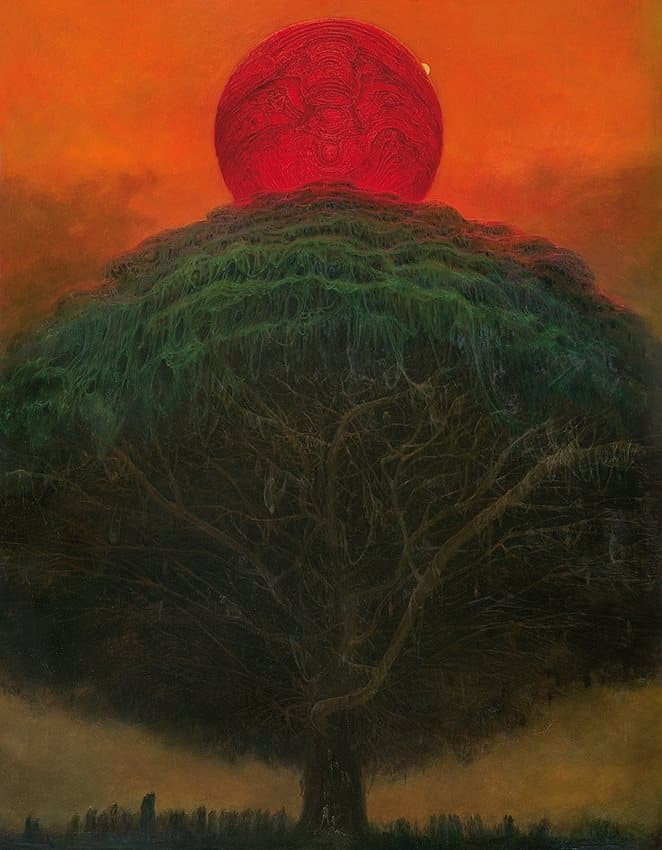
“I drew a face that seemed gentle to me. A familiar journalist from the women’s press came to me and said: “This is a terribly leathery face.” I thought: “Jesus Christ, I want to draw a gentle face, and people associate it with the apocalypse.”
It is strange to start with such a quote, but it gives a fairly coherent understanding of how much we are mistaken in our interpretation of art. We can see a gloomy picture when the author changes the plot more than once and puts a humorous message into it. We often look for hidden meanings where they are absent.
An award-winning surrealist artist, a creative photographer, and a person who has experienced a lot of grief – all these descriptions apply to Zdzislaw Beksiński, who, throughout his life, struggled with difficulties and tirelessly painted paintings saturated with emotional experiences, tragedies, fears and echoes of war. Despite all this, his work, overshadowed by longing, sadness, and pain, has found recognition throughout the world, going down in history as a dystopian art that is similar to Lovecraft’s stories.
What is the uniqueness of Beksiński?
He is one of the brightest artists in Poland. When Beksiński started, almost no one worked in this genre. There were several surrealist artists, but their work was not as “crazy” in a good way as his.
Beksiński was an original, but judging by the photographs, a smiling man. He did not receive an art education and was not a Union of Polish Artists member. Critics did not digest him, and he did not even come to the opening of his exhibitions. He rarely gave interviews; despite this, in the 1970s, his work sold very well. He was on his own, but he had everything.
It’s hard to look at the works of Zdzisław Beksiński for a long time – the artist seems to bring out into the light of day the most terrible and voluminous images from your nightmares. Cold colors and bizarre shapes open a window to the underworld, where gigantic spaces lie where the vilest creatures await you. Something similar was instilled in readers by Lovecraft, to whom we owe the outlines of those creatures about which he wrote. Yes, precisely outlined because Howard did not often succeed in details or details, and for readers, there were always creatures – terrible, chilling blood, vile and dark. In turn, Beksiński gives us a clear idea, with all the details, scars, and blood.
Cursed Artist
There were legends that the Beksiński family was cursed and that his son Tomasz, who constantly wore a black cape with a hood, was sleeping in a coffin. But it was just gossip that appeared because their family lived rather secluded. Zdzislaw was cheerful – not like his paintings.
He was a pleasant man, intelligent, and well-read. He loved music: in his youth, he listened to rock, and towards the end of his life, he was fond of the classics. Incredibly creative – he tried himself in photography, drawing, heliography, avant-garde sculpture, and in later years – computer graphics. Beksiński was looking for an outlet for his creative potential in various forms and, at the same time, behaved like an ordinary person. After all, some artists are eccentric, like to appear in public, dress brightly, and want to be on the covers of magazines. Beksiński was an introvert and a perfectionist, and he preferred to stay at home and create his own little world.
True in the Eyes
What does the artist say about his paintings? Almost nothing. He very rarely commented on his works and didn’t even give them names. He wrote in his diaries that his paintings should be shown without descriptions and dates. From the beginning, Beksinski deliberately avoided creating any context for his works, including in conversations with loved ones. For example, the cross in his paintings is not associated with religion, and the coffins and bones are not a reference to the times of war. He wanted to leave the audience room for imagination. By the way, once he was asked about the image of crosses. He said that in Poland, crosses are found every hundred or two hundred meters, and it is strange if they are not in the paintings.
The central object in Beksiński’s paintings was often the cathedral. Recently, when the Notre Dame Cathedral burned down, many people associated Beksiński’s paintings with this event, alluding to prophetic abilities. But Zdzislaw said that he did not have such abilities and that it was all an accident. Like any artist, he did not want to say everything about the picture – everyone understood how he wanted to hear what was in his head. [Chinese artist Guang Yang, for example, finished work on the installation “Giger in a coffin,” and the next day, Giger died after falling down the stairs, coincidence?].

End Art
The works of Zdzisław left an impressive mark on the history of surrealist art. After his death, the society erected a cross in his memory, and in 2006 a museum dedicated to him and his work was opened in his hometown of Sanok, Poland. His collections are also represented in the National Museum in Wroclaw and the National Museum in Warsaw. In addition, he was awarded the Polonia Restituta (“Polish Revival Order”), a Polish award recognizing excellence in the arts, science, sports, culture, education, economics, and many other fields and disciplines.
Throughout his life and after his death, young creative people have continued to be inspired by his work: music, paintings, and even an online game called “Tormentum” was created, which was developed in 2015, paying tribute to his art.